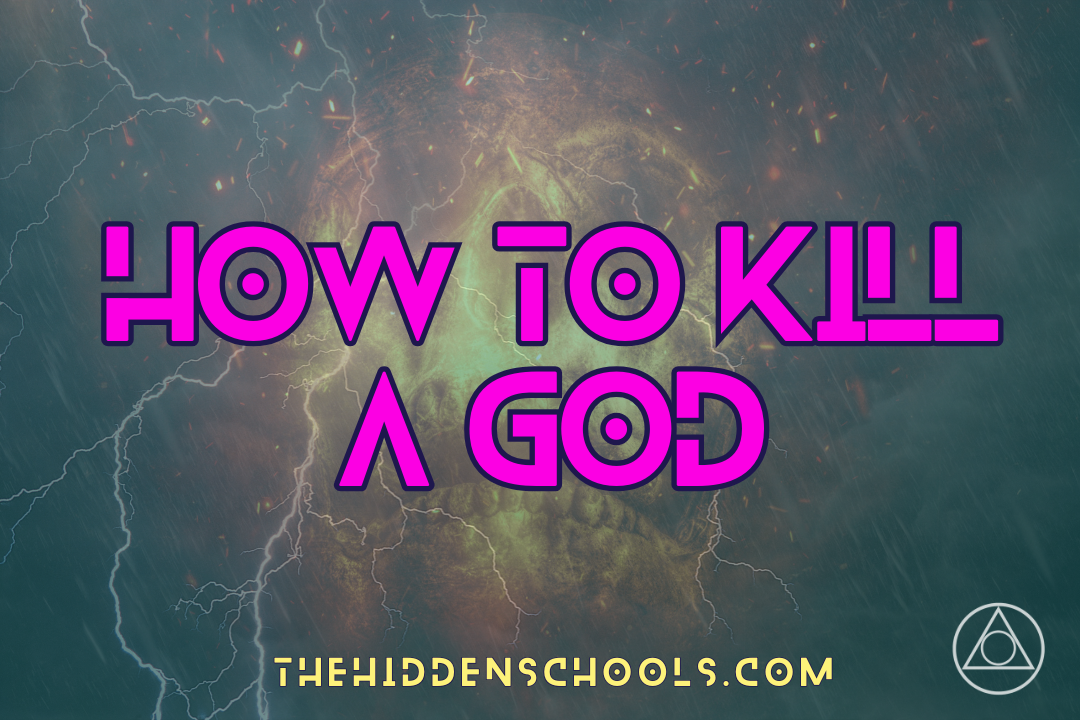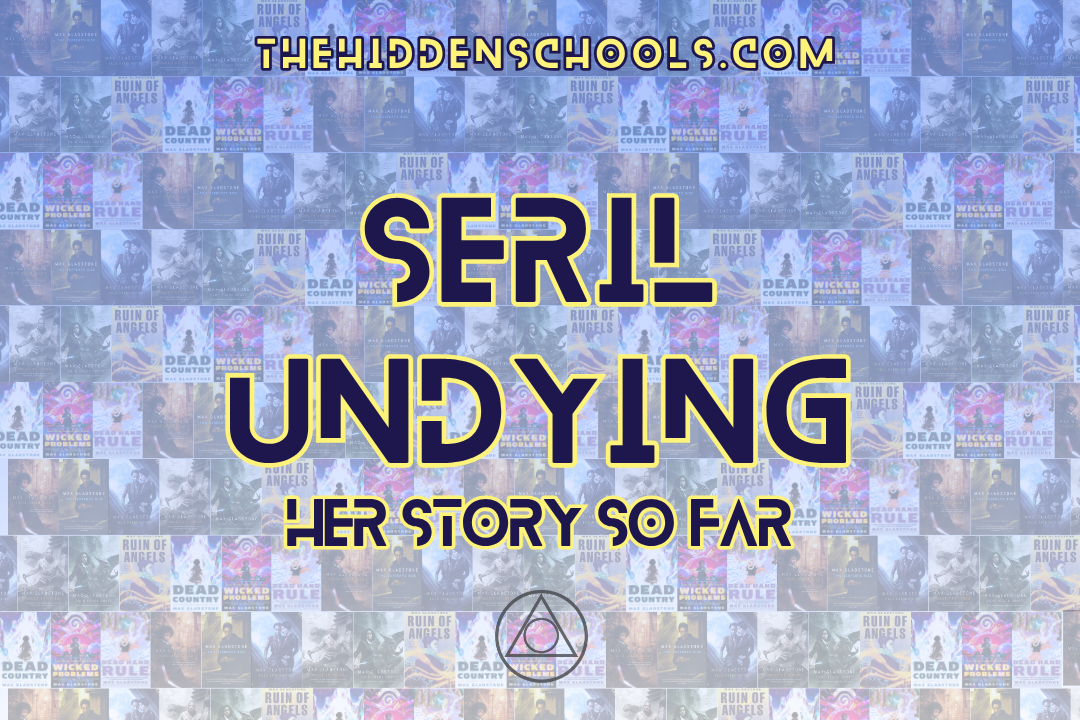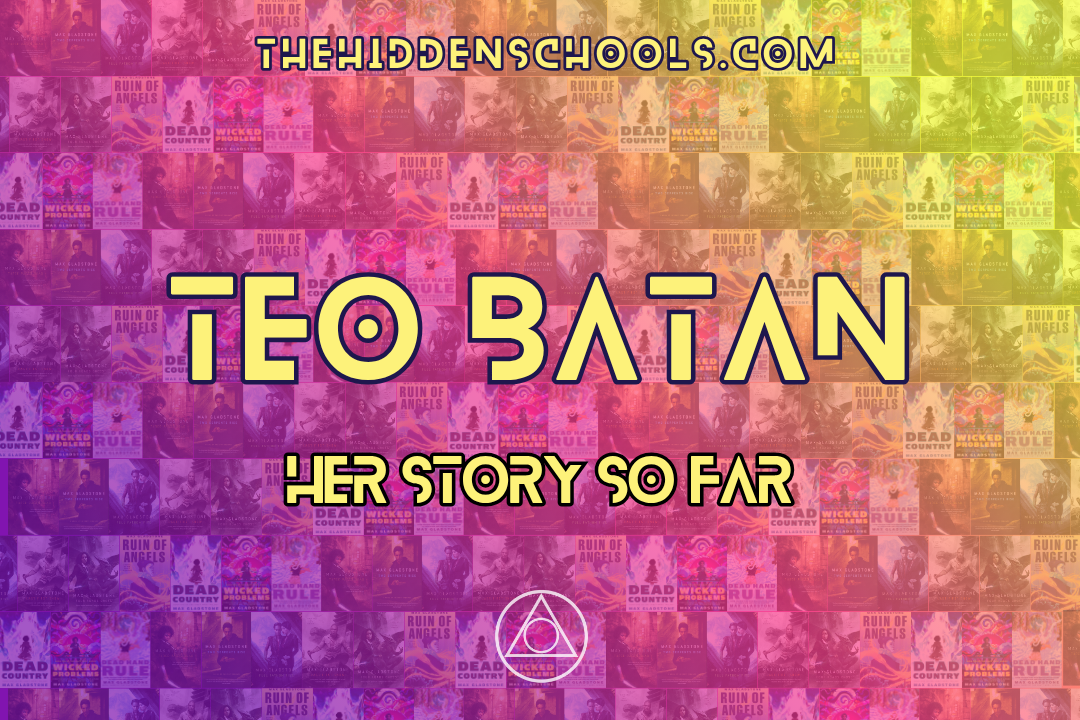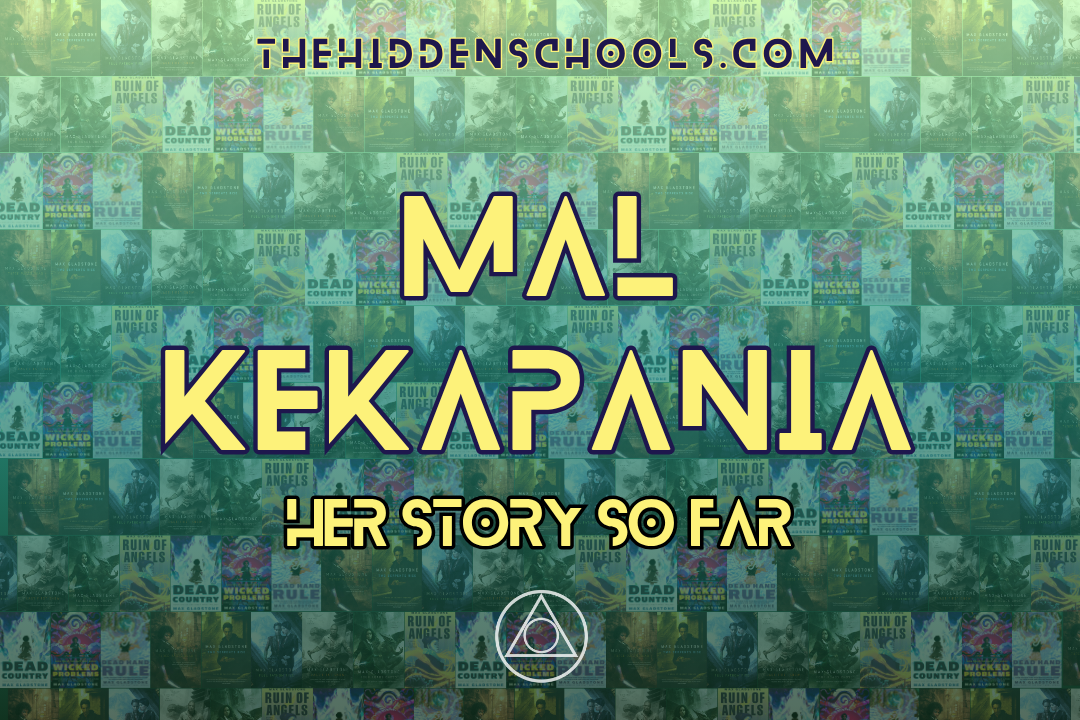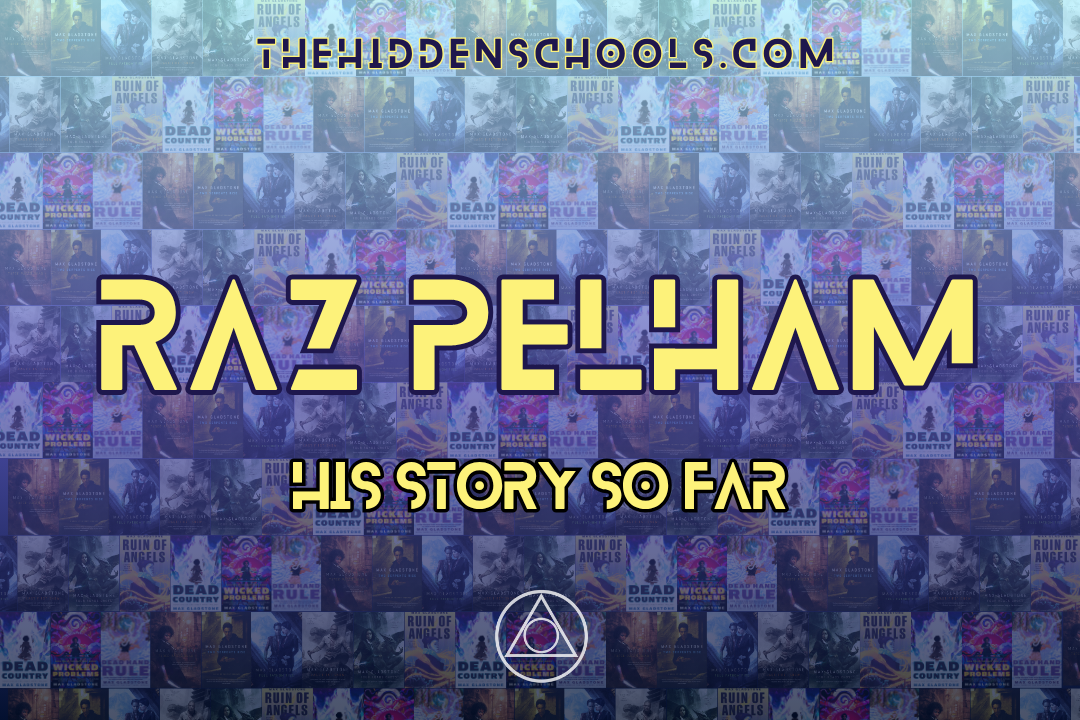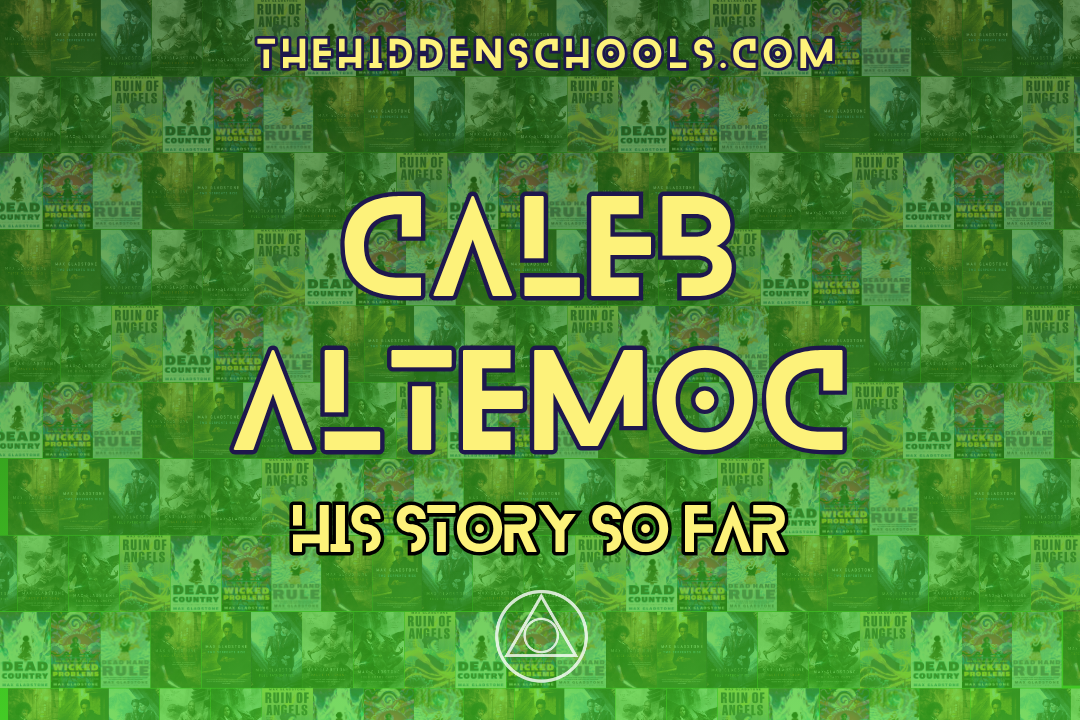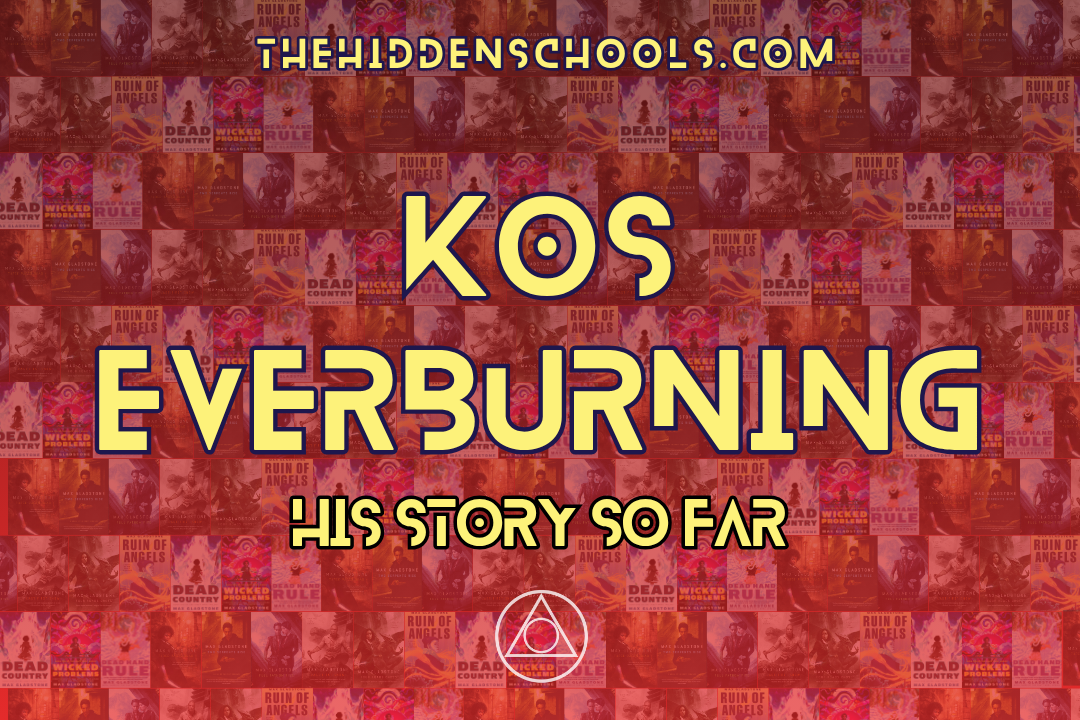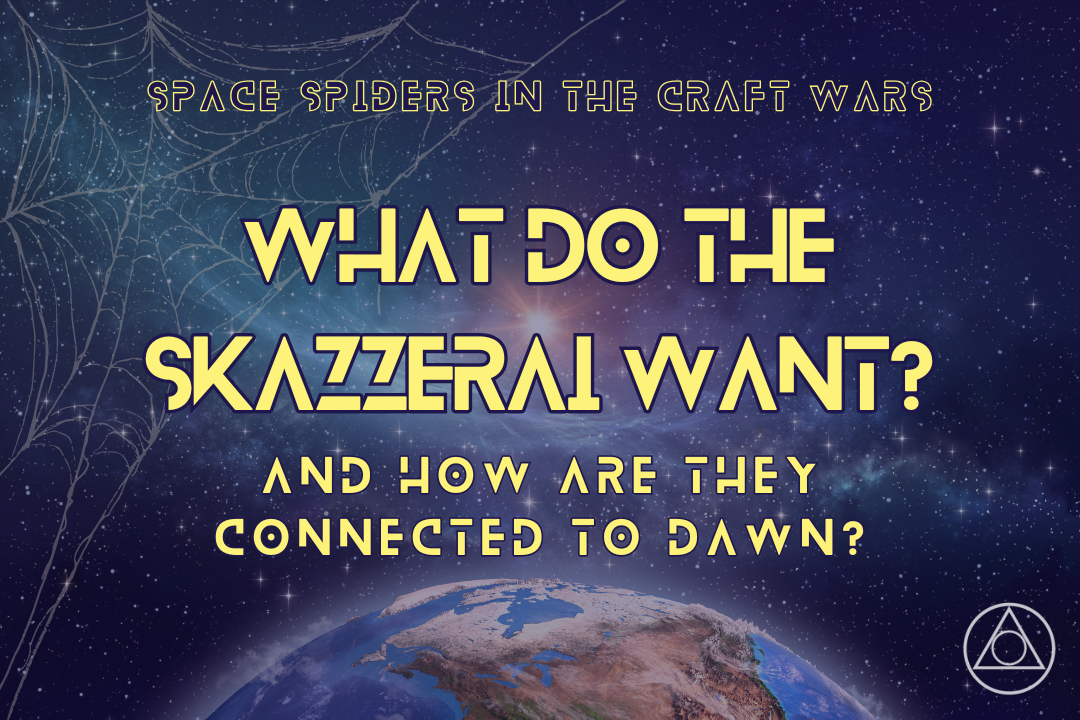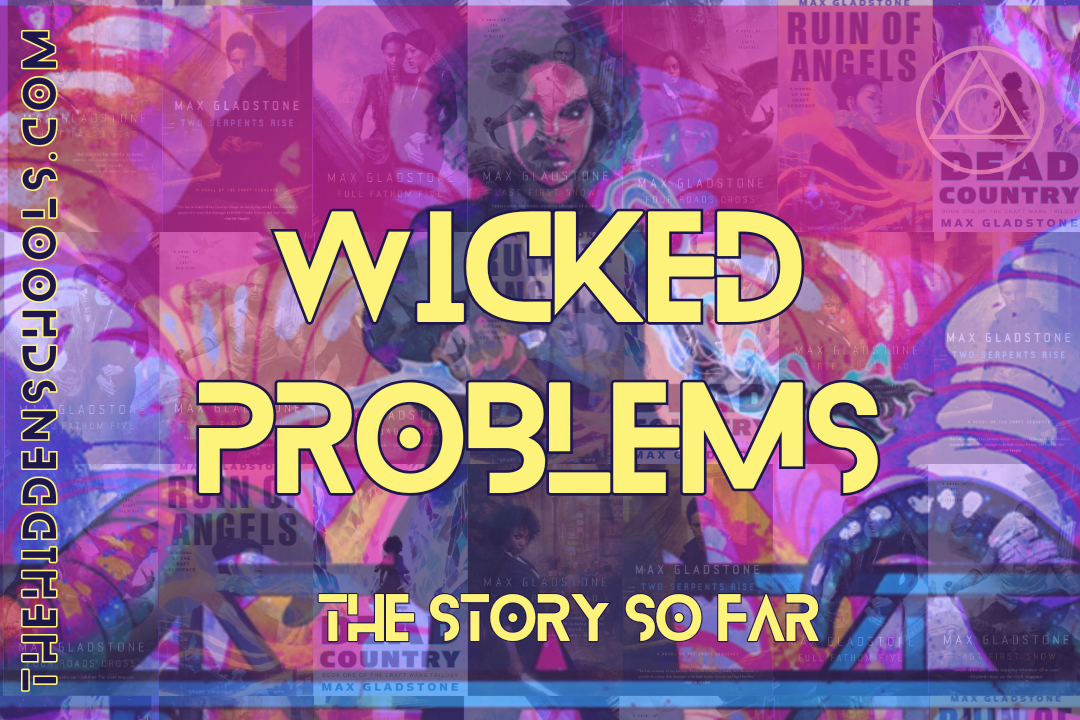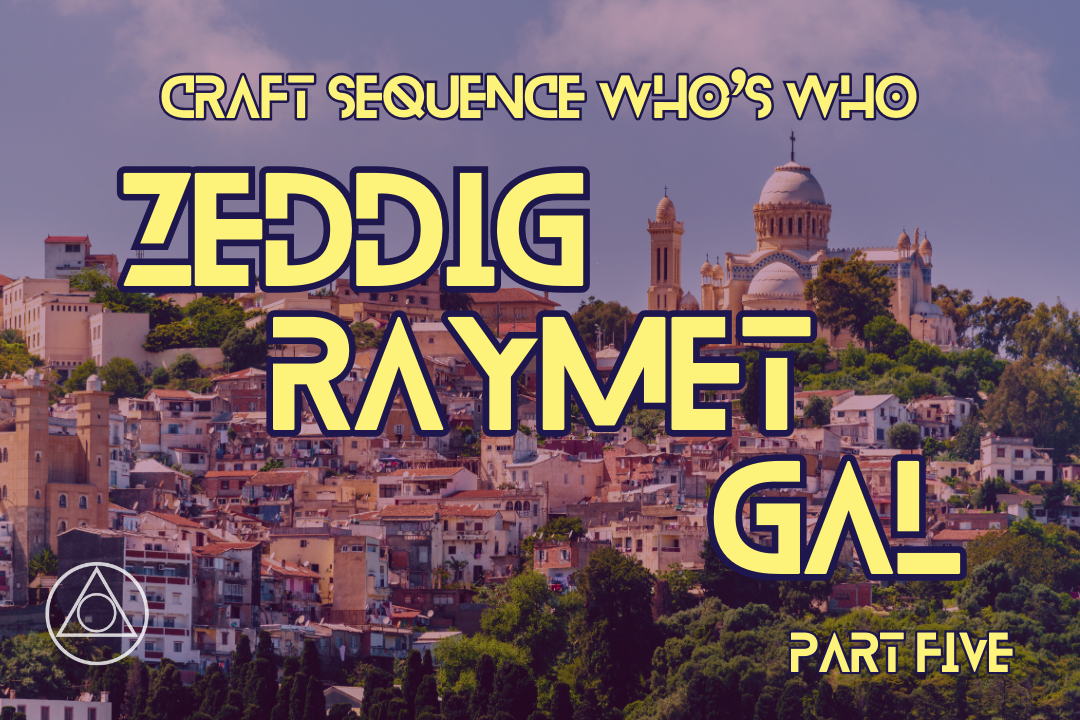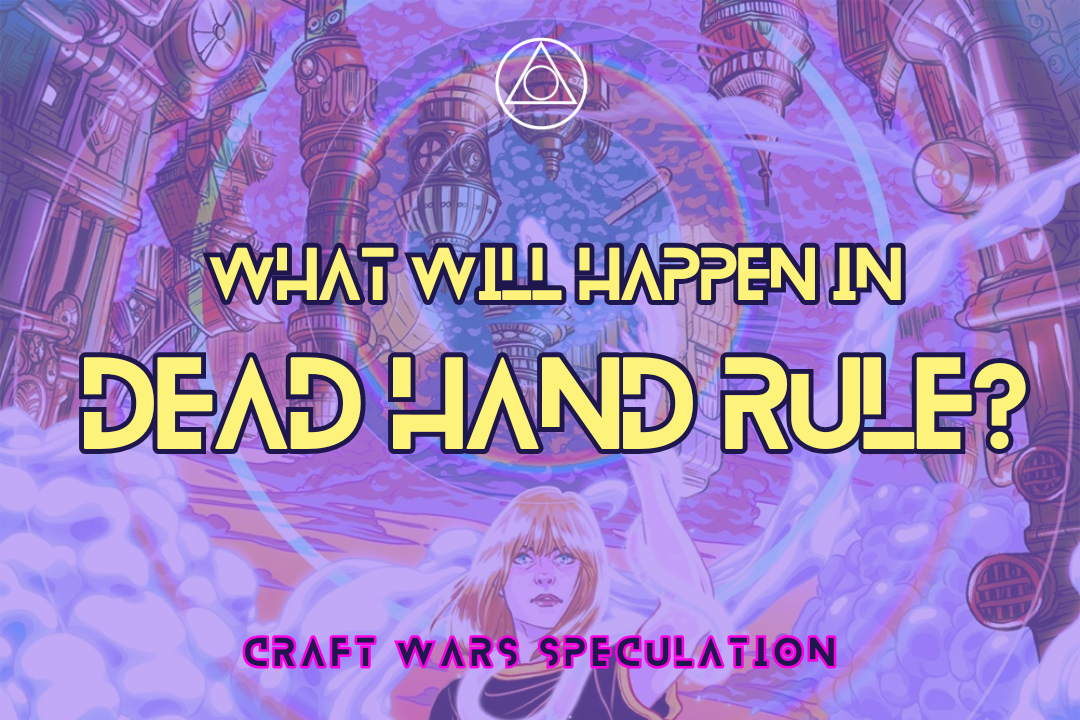How to Kill a God
“What do you know, Ms Abernathy,” he said, “about the death of gods?”
Not sure about anyone else, but I always hear this said like Barbossa’s line in all the Pirates of the Caribbean trailers - “You’d best start believing in ghost stories, Miss Turner. You’re in one.”
The death of gods is integral to the Craft Sequence. Our first book is based around the conceit of Kos Everburning’s death and subsequent resurrection – along with the resurrection of his lover Seril Undying, thought to have been killed decades before. The entire background of the world is based on the God Wars, where countless gods were slain.
But, how do gods die? How do you kill a god?
The early Craftsfolk had similar questions. This essay outlines the answers they uncovered.
Usual disclaimer for spoilers across all published books.
What exactly are gods in the Craft Sequence
Gods are undeniably ‘real’ in the Craft Sequence. Faith and belief sustain them, but you don’t require such faith and belief to accept their existence. Atheism in the Craft Sequence means not worshipping and relying on a god, not denying that gods are out there.
They are not, however, beings that exist outwith people. They weren’t there first as omnipotent powerful beings, sculpting humans from matter and breathing life into them (though most religious traditions in the Domain do have some such origin story).
Gods and goddesses instead grew alongside people and cultures.
“Gods are stories people tell. The Hidden Schools claim gods evolved with us. We ordered the world in our minds, and our stories gather strength and power. Through them we become more than meet, and through us they become more than wind. Faiths are eyes through which we know the world. Gods and goddesses sing ourselves back to us through time.”
Whether people or gods came first is unclear, and frankly unimportant. Very chicken and egg. In the modern day, it is not only Craftsfolk who believe this, but priests too. We are first given an introduction to gods by Cardinal Gustave in Three Parts Dead, who describes both their evolution and similarities to humans:
“Gods, like humans,” he said, “are order imposed on chaos. With humans, the imposition is easy to see. Millions of cells, long twisted chains of atoms, so much bone and blood and juice, every piece performing its function. When one of those numberless pumps refuses to beat, when one of those infinitesimal pipes gets blocked, all the pent-up chaos springs forward like a bent sword, and the soul is lost to the physical world unless something catches it first.
“So, too, with gods. Gods live and reproduce much like humans, and, like humans, their higher functions (language, pact-making, careful exercise of power, sentience) developed quite recently on the timescale of eons. In the unrecorded mists of prehistory, when mankind prowled the savannah and the swamps, their gods hunted with them, little more than shadows on a cave wall, the gleam in a hunter’s eye, a mammoth’s death roar, as primitive as the men they ruled. As men grew in size, complexity, and might, the gods grew with them.
“God, like men, can die. They just die harder, and smite the earth with their passing.”
So, everyone is in agreement that gods exist, that they evolved with humans, and they have sentience. But how do they actually work?
I’m (slowly) examining different aspects of how magic works in this series here, both in terms of Craft and Applied Theology, but for the purposes of this essay, these are some of the critical components:
Magic requires a battery of sorts (gods use the soulstuff of their believers offered through worship and sacrifice)
Magic is channelled through specific shortcuts that relate to long-form agreements, contracts, and traditions (for gods, this may be scars on priests’ bodies, scripture, specific forms of worship, or, since the rise of Craft, legal contracts)
Magic shapes reality through words and belief (you cannot fly in Alt Coulumb becomes Seril owns the skies and she hasn’t given you permission; Seril is given a boost of power at the end of Alt Coulumb because the Rafferty sisters gather believers and weave their stories together into a strong narrative)
Magic is based on exchange (you give me a sacrifice, I protect you; I breathe in all the life from this oasis and it dies but I live)
These principles are true across the Domain, but look different in each case depending on the relevant culture’s needs and the ensuing power of the gods. The Blue Lady developed as a goddess of thieves and street kids. As we see in Ruin of Angels, she isn’t a goddess of last stands and her power cannot work that way; but she’s damn good at running, evading, and tricking her opponent. A god of a warrior people will be better at traditional battle, and by retreating will lose power – even though the same principles power the warrior god and the Blue Lady.
As history developed, individual gods and communities grew in power, but it was when they linked up and combined in a global system that power grew exponentially:
“Gods, however, made deals. It was the essence of their power. They accepted a tribe’s sacrifice and in turn protected its hunters from wolves and wild beasts. They received the devotion of their people, and gave back grace. A successful god arranged to receive more than he returned the world. Thus your power and your people grew together, slowly, from family to tribe, from tribe to city, from city to nation, and so on to infinity.
Nice strategy, but slow. Theologians centuries back had developed a faster method. One god gave of his power to another, or to a group of worshippers, on a promise of repayment in kind, and of more soulstuff than had been initially lent. Gods grew knit to gods, pantheons to pantheons, expecting, and indeed requiring, their services to be returned. Power flowed, and divine might increased beyond measure.”
The principles remain, but on a much bigger scale. Through what are essentially legal agreements, gods give and receive power from each other and different polities around the world. The idea, like in our own world, is that you would get more power back – but that can’t be guaranteed. And if you default on your obligation (not being able to offer the power promised to every group, or not being able to pay back your loan), then you’re in serious trouble, god or not.
This system also led to the rise of Craft, which is more or less people using power like the gods, with slightly different batteries, channels, and arguments. And this, in turn, is how we get to the large-scale death of gods.
We’ll return to that later. Now we know more or less how gods work, let’s look at their physical representations – or lack thereof.
Do gods have physical forms that can be slain?
Short answer: yes, no, and it depends.
Most gods don’t really exist tangibly day-to-day. They’re too big. However, through priests and avatars they can have some kind of physicality, which can be harmed. Through the Craft they can also be perceived in a physical way, either in a simulation or after their death.
Let’s look at some examples. This section is heavy on the quotes, but I promise I’ve tried to keep them as succinct as possible.
Well. Succinct by my standards, at least.
“Kos Everburning, like all his divine ilk, did not quite exist in the usual, physical sense of the term—but human minds weren’t good at comprehending n-dimensional noosphere entities, half-network and half-standing wave, propagating in all directions at once through time.
The diagnostic Craft she used had been built to display Alt Coulumb’s God in cross section through time: a three-dimensional flip-book showing a naked continent-szie man whose limbs hung limp in a dark sea, whose face shone too bright to look upon. It was meant to deal with well-structured archival data.
It wasn’t made to model the living operations of the God.
She heard Him breathe”
In both Three Parts Dead and Four Roads Cross we see a somewhat physical depiction of Kos Everburning – in death in the first book, and alive in the latter. Yet this physicality is a representation built via carefully filed documents that Tara can activate to create the simulation. She is able to see power going into and out of Kos from different contracts, but cannot really interact with the physical body here.
Kos is the only full powered god we see in any kind of physical form, and he is simply too big to really interact with the world. Gods as mighty as Kos may be felt by their faithful as a presence, a guide, a feeling, but not engaged with tangibly. As a saint, Abelard has a nearly unique ability to communicate with Kos, and even he does it spiritually rather than physically:
“Gods, or at least the few with which Abelard was on speaking terms, could use human speech, as a person who lacked sign language could point to a flower or a passing cloud. The bigger the god, the harder that became. Rather than reducing themselves to human syntax, larger deities preferred to elevate humans to theirs.”
So, let’s turn to smaller gods. We see a lot of Seril across the series, who was once mighty but is now smaller and weaker than most of her kin. Even so, she doesn’t have a permanent physical form.
She appears in the sky as the moon itself in Four Roads Cross:
“The moon came out.
Before, the moon had been a slender curve. No longer. An orb hung overhead, and there was a face within it Matt recognised from a distant past that never was, and since it never was, never passed. Shadows failed. Silver flame quickened within paving stones.
Alt Coulumb lived. There was a Lady in it, and She knew them.”
Fitting for a moon goddess, no?
She also shows up in some scenes in at least a semi-physical form. Tara is greeted by Seril in her apartment, where Seril takes the appearance of Tara (and Tara’s mother, depending on the angle), and offers a snack of carrots. Quite how tangible she is here isn’t quite clear, but she is at least somewhat able to interact with her surroundings, holding a delightful conversation about matter:
“Carrots.”
“Simple, I grant, but you wouldn’t believe how hard it is to DO things with matter. You’d expect opening a refrigerator door or picking up a kitchen knife to be easier. Every activity on this plane involves so many counterbalancing forces and microscopic, hells, quantum interactions; I would have made you cookies but I never can remember how the proteins denature.”
…
“With so few faithful left, I live at your speed. I think the way you think. Even”—she gestured at her body, Tara’s body—“reduced like this, my mind’s wider than those meat brains of you, but I should be deeper, bigger, the way Kos is. Thinking in this register feels like talking after a helium hit. I sound ridiculous to myself.”
Seril is not quite a solid body, but is more present on our plane than a god like Kos can be. Later in the book she meets journalist Gabby Jones, and takes on a human form – though, once more, it isn’t clear how tangible this form is:
“The goddess condensed to human shape as Jones approached. The moonlight whirl receded behind a surface too slick and shimmering for skin. Gargoyles sang, a chorus whose treble notes flirted with the lower range of human hearing.
…
Jones stood in siler light. The world shifted as she shifted angles, like a hologram postcard. One blink, one turn of the head, and she stood before a woman whose face she almost recognised, not quite Mother, not quite her, not quite Grandma. Another blink, another turn, and the roof was gone and the sky too and the woman, replaced by a frothing silver surf.”
Seril can also be physically present places through her children, the gargoyles. They exist through her power, and their love in turn powers her. We see in Four Roads Cross, that she is vulnerable via the gargoyles and their physical forms, and in Wicked Problems she is able to interact with Kai by essentially possessing Shale’s body:
“Kai did not recognise the goddess at first, because the body she wore belonged to a man—tall, lean, elegant in a light-blue suit, with a fetching sculpted countenance. “My dear!” He spoke Iskari without accent, and with such warmth that she found herself liking him despite his forward manner. “What a joy. It has been entirely too long.”
“I am afraid, sir, that you have met at a disadvantage.”
“Of course, of course,” the gentleman said, as he leaned to kiss the air above her cheeks. “We met, madame, on a memorable occasion, though at the time I wore another countenance. I saved you when you drifted lost on nameless seas. And let us not forget the oh-so-many years of mortal reckoning through which a part of me laboured in your delightful captivity.”
The moon rose in his eyes, and moonsilver glistened from his smile.
“Come,” the goddess said, and took her arm.”
Although this isn’t quite the goddess herself holding a physical form, it’s closer than most gods get.
Our final example is going to be Quechal, with a small hint of Seril. We primarily see and hear about physical bodies of gods once they are dead.
Seril was thought to be killed in the God Wars. Although she did not actually die, we hear that she was “dismembered” and that Justice “was built from stolen pieces of [Seril’s] corpse” (4RC Ch 33). We later hear that “Her killers carved her to pieces. Seril’s butchers took large sections of her portfolio for themselves” (4RC Ch 40). The latter does sound more like a metaphorical butchering – breaking apart her responsibilities and assets rather than her body – but all the descriptions are bodily, and her killers were, of course, necromancers. Seril herself tells us that “The King in Red caught me in the sky, and choked me, and drew his burning knives and began to carve” (4RC Ch 18). It is unlikely that he caught a literal body, choked it, and carved into its skin, but that is the best language Seril can use to describe what happened to her. Kopil himself, admittedly a drama queen, says he “tore your goddess open and ripper her heart and lungs from the ruin of her chest” (4RC Ch 47).
We see two more sort-of god corpses. In Two Serpents Rise, Caleb shows Mal the horror of what remains of Qet Sea-Lord:
“A god lay in the pit. No statue, no graven idol could compare to this imperial thing. Spread-eagled, suspended in dark water, he was the size of a mountain. His massive lips, softly parted, bared teeth as large as carriages. His eyes were sails, his chest broad as a pyramid. Legs and arms thick and long as magisterium trees hung limp in the dark water that lapped at his sides.
…
Qet Sea-Lord was not dead, but not alive, either. His closed eyes did not move like the eyes of a dreaming man. Thick metal pipes protruded from his arms, his chest, his neck, his corded thighs, to join the hive of plumbing below the surface of the water. Silver bands circled his chest. Before each breath, the bands glowed with unearthly light, and after each breath the light faded.
…
“I heard he lived somewhere, in chains.”
“Those are chains”, he said, “of a sort. Qet fought the King in Red during Liberation. The Sea-Lord was broken on his own altar. But he didn’t die.”
“He didn’t survive, either.”
“Yes. He’s not strong enough to have a mind anymore. Flashes of awareness at most, on high holy festivals. Once in a while, he cries out, or babbles nonsense. But his power remains.”
“And so you use him. In pain.”
“We use what’s left of him. He was the bringer of rains from the ocean, Father of the Green Beside the Desert. We pump saltwater into his heart, and as the water runs through him, he removes the salt. He didn’t have such a physical form, before—like most gods. What you saw was a salt statue grown in his image.”
Again, we see he didn’t have a physical form before his death, but there was clearly something that could be made tangible. He had an image, and that image could be made into a statue, which then held whatever was left of Qet’s soul / self / power.
I imagine something similar happened to Ixzayotl, but it isn’t quite clear. Dawn sees the body of a god in the water, and is able to resurrect it. Whether the body is a more literal form of the god, something more akin to the salt statue of Qet, or another form of physicalising the spiritual isn’t quite clear. It does now have physical shape:
“The water was still and clear. Impossibly clear. No trace of silt or sand or fish or floating seaweed. Just a weight of light plummeting as deep as mountains to the ocean floor. To the body of the god.
She could not tell how big he was. Larger than the star kraken, larger than the Arsenal or the pirate ship. She gazed upon the landscape of limbs, the shrunken flesh, the vacant pits that once were eyes, the coral in his hair. They had driven spikes through his wings into the abyssal plane. And then there were the pipes. They ran all over and through him, tracing arteries and veins, piercing ragged flesh, boring into the flayed chest to reach the still heart.
…
“Ixzayotl. One of his Kathic names was the Eagle Who Faces East. Craftsmen felled him. They took what they could use and left the rest. The equipment wasn’t well sealed, and it’s decayed since. It drains life from anything nearby, not just the body of the god. It even stills the sea. But he remains, if we can bear to look.”
...
The god was gone, beneath the dead and crystal water, but much remained—bones like mountains, crystal flesh, tattered skin crusted with coral and stiff from long stillness. The body endured and remembered. It remembered blades and it remembered the lightning tree of thorns, it remembered the King in Red and it remembered Belladonna Albrecht and it remembered its fall, and after that the drills and the pipes and the mites drinking from its veins. It remembered being taken and used.
It remembered rage.
The god burst from the water. Its tattered wings spread broader than the Arsenal. Deathless fires burned in the skeletal pits of its eyes. Curved and ship-long teeth parted, and it loosed a roar that put the clouds to flight and blushed the blue sky crimson.
Eyes of deathless fire peered down and saw the thing that once had been a man, the thing on spider legs. It smelled of lightning and iron, and of chains.
The god’s fist came down. A silence followed.
…
Together, they stared into the face of the god. It was there at the edge of the platform, like the sky was there, or death. The nose was gone; the remaining skin had shrunk over the skull like a mask. The god’s eyes were caverns lit by Craft-fire, and winding feathered hair drifted its shoulders like a lion’s mane.”
Temoc, the last Eagle Knight, recognises Ixzayotl, and says he was there for the god’s death. Whether that means he was present at a physical last stand where Ixzayotl fell into the water where his body was later mined, or if the body was a later Crafty addition, remains unclear.
So, now we know how gods work in the Craft Sequence, and the ways in which they do – and don’t – have physical forms that can be harmed.
Now let’s get back to the main question: how do you kill such powerful, intangible beings?
How to kill a god
“This is the simplest way to kill a god,” Tara said. “You find a flaw in his defenses. A deal that cannot be broken. A treasure the god cannot help but defend. Then you hammer it until the god breaks.”
There we have it. Essay over.
I jest. Let’s look into Tara’s statement in a bit more depth.
What does it mean to find a flaw in a god’s defenses, a deal that cannot be broken, a treasure they cannot help but defend? They key word here is, I believe ‘cannot’. We’re not talking about deals and treasures in our world. We’re talking about obligations written in blood and laced in soul. If you break the deal, you die. If you let the treasure go, you die.
The Seril case is of particular use here. We don’t get the Crafty details of how she nearly died the first time, only that the King in Red carved her up, and she fled into the hearts and minds of her gargoyles. However, the plot of Four Roads Cross revolves around the response to Seril’s return. In particular, Madeline Ramp starts a legal process with the end goal of taking apart what is left of Seril - killing her, this time properly. We see from several points of view what this actually looks like.
Seril in Four Roads Cross is, of course, weaker than your standard god in the Domain. Nonetheless, this example demonstrates how Craftsfolk have gone about killing gods since the start of the God Wars, writ small.
First of all, they had to stop Kos from defending Seril. In the Wars, I imagine this might have been done by directly attacking Kos, preventing him from expending his power on Seril. In the current day, however, Kos is constrained by legal and economic agreements, and is essentially forced to abandon Seril. Seril’s other allies were killed in the Wars, and she hasn’t had time to make new, powerful alliances. A goddess standing alone has access only to her own power base, and is thus more at risk.
Relatedly, they want to reduce her worship base. Were Kos being attacked, the faith of all Alt Coulumb residents would give him power. Seril’s current base of worshippers is small: a few disparate worshippers in the Paupers’ Quarter, maybe a few individuals who have held onto their old faith (like Temoc does for the Quechal pantheon). These people don’t have a cohesive liturgy or rituals through which to transmit their faith to Seril as power. When Kos’ priests and parishioners pray, he gains power. There is a standard liturgy preached in his churches. Seril’s situation is more complicated:
“Jones felt them: a square of people offering themselves. Trade was a pale echo of this feeling, of raw self offered up to Someone who knit it to a whole.
There were so many tales.
Hundreds clashed and recombined in the market, bitter with suffering, gingered with joy. They drew sparks when they struck. Every person here knew the Goddess in a different way. They lacked the tongues to name Her, myths and prayers to fit Her. They offered themselves with love or humility or fear or pain, and if the Goddess accepted them all, She would break herself to shards.”
Seril’s lack of a defined liturgy is a relatively unique weakness, so I won’t dwell on it. A more generally applicable weakness seen above, however, is the role of consistency in general.
We know that Craft is based in part on the strength of a Craftsperson’s argument. A Craftsperson attacking a god will try to poke holes in their theology, in their agreements, in their very being. We see this in Daphne Mains’ attack on Seril:
“Perhaps the spirit who called herself Seril was not the same as the Goddess who died?
Daphne cut through Tara’s argument: the goddess who fought in the Wars had changed to the point of death. She fought Craftswomen, and now employs them. She ruled, and now she hides. Her body was remade. Her mortal worshippers are gone, or long since converted to other faiths. She was a ghost surviving in a few monsters’ dreams. The being who emerges, reborn, is not the lady who fell at the King in Red’s hands, her blood smoking on his claws.”
You can see, therefore, how an inconsistent theology leaves a goddess open to attack.
A goddess can also be weakened via physical representations of herself - that’s why the discussion of physical bodies above was so important. There is rarely an actual single physical goddess who can be attacked and killed, but she is vulnerable through any physical depictions or avatars. In Seril’s case, she is at risk via her children - the gargoyles.
We see this earlier in Four Roads Cross, when demons attack:
“The demons attacked Her children. Seril sustained the gargoyles as they fought, and she fought on their behalf: moonlight trapped one demon-bug in silvery crystal, and time slowed for another. But there were so many, and as the gargoyles fell, the demons drank, and Seril weakened. This was how you fought a goddess: tore her between obligations until She spent herself in Her people’s service. You built unwinnable scenarios and forced her into zero-sum games.”
The gargoyles are powered by Seril, and they defend Seril, but she can be attacked through them. She is unable to simply abandon them: they are built from her. In a way, they are her. Were Seril to attempt to remove her power from them, she would be undermining her very self, offering up an inconsistency for her enemies to attack. Yet if she continues to power them, she is physically vulnerable through them. We see this in the final battle too, reading that “When Daphne’s Craft pierced rock skin, she drank moonlight. The goddess went down sweet and sour, like buttermilk" (4RC, ch 65) and that when she argued against the gargoyles’ ability to fly and fight given their bodies are stone, “The goddess convulsed.”
All gods have something physical imbued with their power: it may be something like the gargoyles, or it could be the priesthood. When Temoc’s fellow Eagle Knights fell, the Quechal gods were weakened. They are partially sustained through him even know; were he to be killed, the last murmurings of the Quechal pantheon would die too.
What does this mean for Craft Wars?
Seril is, lucky for the story, not killed at this point. We actually haven’t seen many gods die in the story itself. Kos was faking; the Quechal gods died before the story started; the Blue Lady is alive despite her masks being killed.
Is Ajaia the only god death on-page? She handed her obligations over to Dawn almost completely; is Dawn, perhaps, Ajaia mark 2?
I imagine we will see some more fall before the end of the Craft Wars quartet. I am particularly concerned for Kos. Abelard spent a lot of time in Wicked Problems pondering what Kos would look like when he went to war. Abelard is also a saint, and at the end of that book almost sacrificed himself to save Dresediel Lex; might this foreshadow Kos doing something similar before the end of the series?
If not Kos, I think we shall see more gods fall. There aren’t all that many left, but the ones that are won’t be able to stay out of the war with the skazzerai that is to come.
What do you think? Let me know - and don’t forget you can subscribe to be the first to hear about new articles and fun projects in the pipeline. Like what we do here? Tips welcome on ko-fi to help pay for the site!

